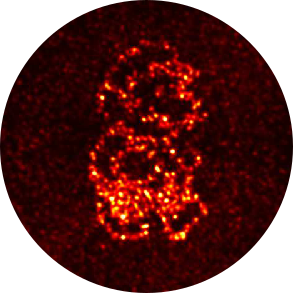The vision of OPTIMlab’s research programmme is “to image where no-one has imaged before”. This overarching vision is underpinned by 3 research themes across several research areas, shown in the diagram below.
Click on a research topic in the map to learn more

Machine learning: Recently we have shown use of deep neural networks for single-ended recovery of optical fibre transmission matrices, and use of advanced multi-task conditional networks for interpretable machine learning of time-resolved ultrasound. Prior to this, we have use advanced computational techniques for optical fibre characterisation, image reconstruction and analysis of biological data. We also apply cutting edge machine learning techniques such as reinforcement learning to solve other interesting problems.
Cancer imaging: We are developing new optical tools for improving imaging of early cancer. In particular we are developing new endoscopes that use cutting edge imaging techniques to increase contrast of early tumours and that are clinically translatable
Endoscopy: We develop new types of optical endoscope for medical imaging that can see disease (e.g. cancer) more clearly used advanced imaging technologies, most recently world’s smallest spatial frequency domain imaging system. We have also demonstrated endoscopic optical phase and polarisation imaging, hyper-spectral imaging and fluorescence imaging. We publish highly multidisciplinary work in major medical journals.
Adaptive optics: We use liquid crystal spatial light modulators, digital micromirror devices and customised tunable lenses as adaptive optical elements for applications in optical fibre imaging, telecommunications and optical computing.
Low cost imaging: We develop new imaging approaches that can achieve advanced imaging modalities in compact form factors, paving the way for widely-deployable imaging tools for targeted screening of early cancers such as capsule endoscopes.
Plasmonic metasurfaces: We use nanotechnology fabrication techniques to create metallic and dielectric features smaller than the wavelength of light, which enables carefully tailoring of optical properties (including polarisation and spectral transmission) to enable new ultra-compact multi-modal imaging systems.
Computational imaging: We develop and adapt computational techniques for reconstruction of images through optical fibres in feature spaces relevant to medical imaging, and for new ways of analysing optical fibre transmission matrices required to implementing advanced imaging modalities.
Optical fibre imaging: We develop and experimentally implement new systems that can take images through hair-thin optical fibres, including novel approaches to transmission-matrix measurement, imaging phase and polarisation through fibre for tumour detection and development of the first truly reflection mode fibre characterisation system without active elements on the distal tip. We have also contributed to improved methods for fibre transmission matrix characterisation including stabilising interferometric methods.
Digital holography: We develop new methods in digital holography including for next-generation holographic projectors for augmented reality applications, high-speed hologram generation and optical computing.
Polarimetric imaging: We develop new methods for detecting and analysing polarimetric properties of objects (including Bayesian polarimetric parameter estimation) that can be used to infer important information relevant to disease diagnosis.
Clinical translation: This theme covers our interests in moving new optical imaging technologies towards clinical applications such as improved detection of cancer. This is achieved through close links with clinicals at Nottingham University Hospitals NHS Trust and has led to related clinical studies helping address the COVID-19 pandemic, including work on improved ventillation in endoscopy rooms, impact of bronchoscopy masks on aerosol generation in endoscopy and the relative aerosol production of cytosponge procedures.
Optical imaging: This theme covers our interests in imaging through optical fibres to make hair-thin endoscopes, imaging polarimetric properties of samples to reveal “invisible” information and using digital holography for the next generation of imaging and display technologies.
Novel optical materials: This theme covers development of new optical metasurfaces with bespoke optical properties, offering unprecedented control over wavelength, polarisation, amplitude and phsae. It also includes novel bespoke adaptive optics technologies such as tunable lenses and low-cost imaging technologies.
